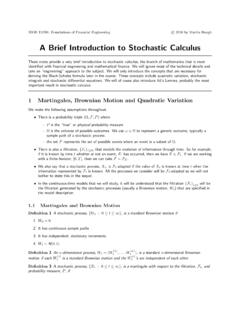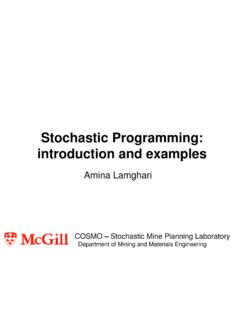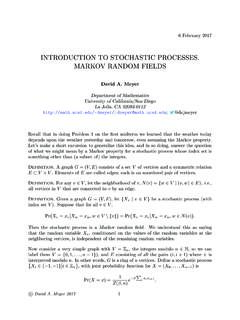Transcription of Chapter 3 An Introduction to Stochastic Epidemic Models
1 Chapter 3An Introduction to StochasticEpidemic ModelsLinda AllenAbstractA brief Introduction to the formulation of various types of stochas -tic Epidemic Models is presented based on the well-known deterministic SISand SIR Epidemic Models . Three different types of Stochastic model formu-lations are discussed: discrete time Markov chain, continuous time Markovchain and Stochastic differential equations. Properties unique to the stochasticmodels are presented: probability of disease extinction, probability of diseaseoutbreak, quasistationary probability distribution, final size distribution, andexpected duration of an Epidemic . The Chapter ends with a discussion of twostochastic formulations that cannot be directly related to the SIS and SIRepidemic Models .
2 They are discrete time Markov chain formulations appliedin the study of epidemics within households (chain binomial Models ) and inthe prediction of the initial spread of an Epidemic (branching processes). IntroductionThe goals of this Chapter are to provide an Introduction to three differentmethods for formulating Stochastic Epidemic Models that relate directly totheir deterministic counterparts, to illustrate some of the techniques for ana-lyzing them, and to show the similarities between the three methods. Threetypes of Stochastic modeling processes are described: (1) a discrete timeMarkov chain (DTMC) model , (2) a continuous time Markov chain (CTMC) model , and (3) a Stochastic differential equation (SDE) model . These stochas -tic processes differ in the underlying assumptions regarding the time andthe state variables.
3 In a DTMC model , the time and the state variables areDepartment of Mathematics and Statistics, Texas Tech University, Lubbock, TX 79409-1042, Allendiscrete. In a CTMC model , time is continuous, but the state variable is dis-crete. Finally, the SDE model is based on a diffusion process, where both thetime and the state variables are Models based on the well-known SIS and SIR Epidemic mod-els are formulated. For reference purposes, the dynamics of the SIS and SIRdeterministic Epidemic Models are reviewed in the next section. Then theassumptions that lead to the three different Stochastic Models are describedin Sects. , , and The deterministic and Stochastic model dynamicsare illustrated through several numerical examples. Some of the MatLab pro-grams used to compute numerical solutions are provided in the last sectionof this of the most important differences between the deterministic andstochastic Epidemic Models is their asymptotic dynamics.
4 Eventually stochas -tic solutions (sample paths) converge to the disease-free state even thoughthe corresponding deterministic solution converges to an endemic equilib-rium. Other properties that are unique to the Stochastic Epidemic modelsinclude the probability of an outbreak, the quasistationary probability distri-bution, the final size distribution of an Epidemic and the expected durationof an Epidemic . These properties are discussed in Sect. In Sect. , theSIS Epidemic model with constant population size is extended to one with avariable population size and the corresponding SDE model is Chapter ends with a discussion of two well-known DTMC epidemicprocesses that are not directly related to any deterministic Epidemic two processes are chain binomial Epidemic processes and branchingepidemic Review of Deterministic SIS and SIR EpidemicModelsIn SIS and SIR Epidemic Models , individuals in the population are classifiedaccording to disease status, either susceptible, infectious, or immune.
5 Theimmune classification is also referred to as removed because individuals areno longer spreading the disease when they are removed or isolated from theinfection process. These three classifications are denoted by the variablesS,I,andR, an SIS Epidemic model , a susceptible individual, after a successful con-tact with an infectious individual, becomes infected and infectious, but doesnot develop immunity to the disease. Hence, after recovery, infected individu-als return to the susceptible class. The SIS Epidemic model has been appliedto sexually transmitted diseases. We make some additional simplifying as-sumptions. There is no vertical transmission of the disease (all individuals areborn susceptible) and there are no disease-related deaths.
6 A compartmental3 An Introduction to Stochastic Epidemic Models83diagram in Fig. illustrates the dynamics of the SIS Epidemic model . Solidarrows denote infection or recovery. Dotted arrows denote births or compartmental diagramDifferential equations describing the dynamics of an SIS Epidemic modelbased on the preceding assumptions have the following form:dSdt= NSI+(b+ )IdIdt= NSI (b+ )I,( )where >0 is the contact rate, >0 is the recovery rate,b 0isthebirth rate, andN=S(t)+I(t) is the total population size. The initial con-ditions satisfyS(0)>0,I(0)>0, andS(0) +I(0) =N. We assume thatthe birth rate equals the death rate, so that the total population size is con-stant,dN/dt= 0. The dynamics of model ( ) are well-known [25]. Theyare determined by thebasic reproduction number.
7 The basic reproductionnumber is the number of secondary infections caused by one infected individ-ual in an entirely susceptible population [10, 26]. For model ( ), the basicreproduction number is defined as follows:R0= b+ .( )The fraction 1/(b+ ) is the length of the infectious period, adjusted fordeaths. The asymptotic dynamics of model ( ) are summarized in the fol-lowing (t)andI(t)be a solution to model ( ).(1) IfR0 1, thenlimt (S(t),I(t)) = (N,0)(disease-free equilibrium).(2) IfR0>1, thenlimt (S(t),I(t)) = NR0,N 1 1R0 (endemic equi-librium). AllenIn an SIR Epidemic model , individuals become infected, but then developimmunity and enter the immune classR. The SIR Epidemic model has beenapplied to childhood diseases such as chickenpox, measles, and mumps.
8 Acompartmental diagram in Fig. illustrates the relationship between thethree compartmental diagramDifferential equations describing the dynamics of an SIR Epidemic modelhave the following form:dSdt= NSI+b(I+R)dIdt= NSI (b+ )I( )dRdt= I bR,where >0, >0,b 0, and the total population size satisfiesN=S(t)+I(t)+R(t). The initial conditions satisfyS(0)>0,I(0)>0,R(0) 0,andS(0) +I(0) +R(0) =N. We assume that the birth rate equals the deathrate so that the total population size is constant,dN/dt= basic reproduction number ( ) and the birth ratebdetermine thedynamics of model ( ). The dynamics are summarized in the (t),I(t),andR(t)beasolutiontomodel( ).(1) IfR0 1, thenlimt I(t)=0(disease-free equilibrium).(2) IfR0>1, thenlimt (S(t),I(t),R(t)) = NR0,bNb+ 1 1R0 , Nb+ 1 1R0 (endemic equilibrium).
9 3 An Introduction to Stochastic Epidemic Models85(3) Assumeb= (0)N>1, then there is an initial increase in thenumber of infected casesI(t)( Epidemic ), but ifR0S(0)N 1, thenI(t)decreases monotonically to zero (disease-free equilibrium).The quantityR0S(0)/Nis referred to as theinitial replacement number,the average number of secondary infections produced by an infected individ-ual during the period of infectiousness at the outset of the Epidemic [25, 26].Since the infectious fraction changes during the course of the Epidemic , thereplacement number is generally defined asR0S(t)/N[25, 26]. In case (3) ofTheorem 2, the disease eventually disappears from the population but if theinitial replacement number is greater than one, the population experiencesan Formulation of DTMC Epidemic ModelsLetS(t),I(t), andR(t) denote discrete random variables for the number ofsusceptible, infected, and immune individuals at timet, respectively.
10 (Cal-ligraphic letters denote random variables.) In a DTMC Epidemic model ,t {0, t,2 t,..}and the discrete random variables satisfyS(t),I(t),R(t) {0,1,2,..,N}.The term chain (letter C) in DTMC means that the random variables arediscrete. The term Markov (letter M) in DTMC is defined in the SIS Epidemic ModelIn an SIS Epidemic model , there is only one independent random variable,I(t), becauseS(t)=N I(t), whereNis the constant total population Stochastic process{I(t)} t=0has an associated probability function,pi(t)=Prob{I(t)=i},fori=0,1,2,. .,Nandt=0, t,2 t,..,whereN i=0pi(t)= (t)=(p0(t),p1(t),..,pN(t))Tdenote the probability vector associatedwithI(t). The Stochastic process has theMarkov AllenProb{I(t+ t)|I(0),I( t),..,I(t)}=Prob{I(t+ t)|I(t)}.










